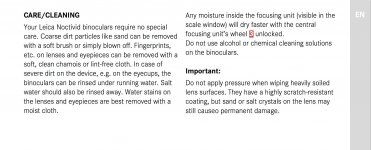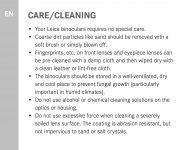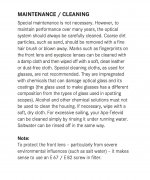John A Roberts
Well-known member

I posted the following earlier today:
As it could have serious implications for Leica users, it’s best to be forewarned.
John
p.s. The 2017 manual for the Apo-Televid Telescope says much the same thing, though in a more roundabout way.
Hi ZDHart (post #9),
I was interested to see Leica's prohibition against using 'alcohol or other cleaning solutions', since I couldn't remember that being said by them (or by Zeiss or by Swarovski). Since it seems that it must be a recent change, I decided to look back through some of the Leica instruction manuals.
They can be found at: Downloads // Support // Service & Support - Leica Camera AG
And:
• the 2013 Ultravid manual has no mention;
• by 2017, the Noctivid manual states 'Do not use alcohol or chemical cleaning solutions on the binoculars' and;
• by 2019, the Retrovid manual states as a seperate dot point 'Do not use alcohol or chemical cleaning solutions on the optics or housing'.
So it's a relatively recent change - and an important one for Leica owners to know - since:
• it's contrary to what some commonly do, especially when cleaning lenses;
• it seemingly may result in either physical damage or the accelerated breakdown of materials, and then;
• it may have implications for someone who sends in a unit for servicing!
It would be useful to know if it's due to an abundance (overabundance?) of caution, or if it's necessary due to changing to more eco-friendly materials.
It also seems to indicate that the outer lens coating AquaDura, is not all that dura.
. . .
As it could have serious implications for Leica users, it’s best to be forewarned.
John
p.s. The 2017 manual for the Apo-Televid Telescope says much the same thing, though in a more roundabout way.
Attachments
Last edited:








